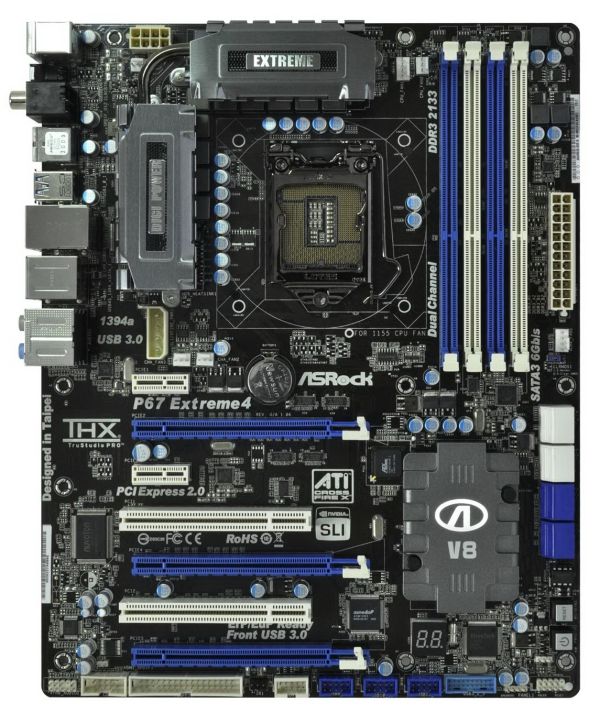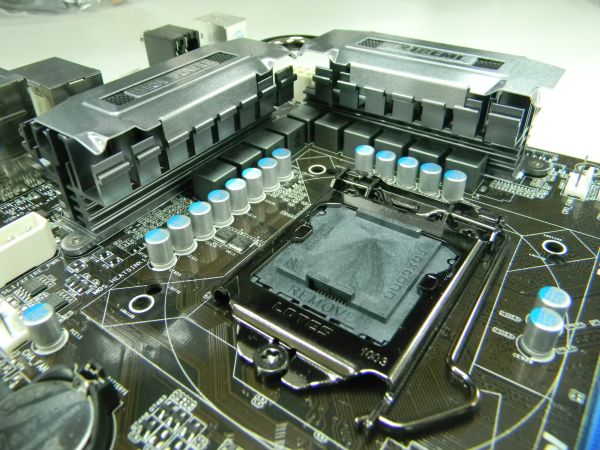Welcome to Sandy Bridge, with the ASRock P67 Extreme4
by Ian Cutress on January 3, 2011 7:00 AM EST- Posted in
- Motherboards
- ASRock
Demand for Sandy Bridge paraphernalia will be high—for almost a year now, the question has always been: Shall I upgrade from X to Y? One of the more popular responses, especially as Sandy Bridge has gotten closer, has been "wait until Sandy Bridge is released; it’s just around the corner." Therefore, each motherboard manufacturer will be trying their hardest to get attention by creating the best product line they can—with as many accessories at the lowest possible price. ASRock are, of course, no exception.
At release, ASRock will have several board on offer, ranging from micro-ATX H67 to top-line P67. The Extreme4 is our candidate today, and represents a standard product that people may actually buy when deciding which Sandy Bridge motherboard to get.
Visual Inspection
ASRock have produced a board in blue and black livery featuring a black PCB. The 8+2 phase power design sports additional heat sinks connected via a heatpipe. The socket itself is relatively empty, and ASRock have included mounting holes for socket 775 coolers as well as the socket 1155/1156 coolers. A few people will say this is a bad idea, as it weakens the board, it increases the tracing route length from RAM to CPU, or that some manufacturers will try to put traces between in the mounting holes. I have never had an issue with it, personally.
The SATA connectors are blue for SATA 3 Gb/s and white for SATA 6 Gb/s. Only two of these white connectors are applicable to RAID, so double check before setting this up. The power and reset buttons are located just below this, in usually what is the easiest spot for testing on an open bench, but not always the easiest spot when the board is inside a case. These buttons are also an issue when running dual GPUs with long PCB lengths—to the extent that the reset button is not useable.
Some people may wonder why new chipsets still have a floppy drive connector on the motherboard. The simple reason is that a lot of industrial hardware still calls for it, and it is cheaper to replace a PC than a piece of industrial equipment costing five or six digits. We will not be seeing the floppy drive connector go away in the near future. However, there is no IDE connector on this board.
The chipset cooler is quite small, and large GPUs will rest on it. If the GPU gets quite warm, or likewise the chipset, then these two components will transfer heat quite easily between them, possibly limiting overclocks. Power hungry 4870X2, GTX 480 and GTX 580 users take note! The PCIe slots are laid out ideally here, with a x1 slot at the top, and if all x16 slots are filled a PCI slot is still available. Certain manufacturers fail in their layout slot, but ASRock have used their brains, giving a tri-slot gap between the main GPU PCIe slots.
There are five fan headers on this board, two of them are labelled CPU and three are labelled chassis. Two of the chassis headers are located above the first PCIe x1 slot, right next to each other, and the other is between the 24-pin power connector and the SATA ports. I would have liked at least one of them to be on the bottom of the board—for wide cases that require a fan further down, this would be ideal.
The back panel is standard, with PS/2 connectors, SPDIF outputs, USB 2, USB 3, Firewire, gigabit Ethernet, and the audio panel. As I will state in most reviews, I always prefer dual Ethernet ports, however this motherboard only has one without utilizing a PCI card. One of ASRock’s marketing statements is their XFast USB technology, designed to increase throughput of their USB ports; we've seen it on a number of previous ASRock boards also. In pure synthetics, ASRock claims up to a 97% increase in USB 3.0 writing speed and a 360% increase in USB 2.0. We will test these in the benchmark suite.














55 Comments
View All Comments
chrnochime - Monday, January 3, 2011 - link
So basically for any CPU that has its multiplier locked, there's just no way to oc the CPU. Either pay up for an unlocked CPU or be content with stock speed. Hmm...wolfman3k5 - Monday, January 3, 2011 - link
I've read all the Sandy Bridge articles that you guys posted. And while at first glance it seems that you're really enthusiastic about the products, they are low end and mid range products. What I take from all the Sandy Bridge articles is that X58 high end platform is obsolete and that everyone should jump on the mediocre Sandy Bridge bandwagon. When I'm saying mediocre I'm not referring to the Core i5 2500K or to the Core i7 2600K CPUs. I'm referring to the rest of the platform and its limitations. No full support for SATA 6.0 (which AMD already had for months), only two 8X PCI-E lanes for high end SLI or CrossFire configurations, only dual channel memory. I mean, it is obvious that this is a new product and that Intel needs to sell it, but it doesn't mean that everyone who got a high end system on a X58 platform should throw it away. Also, the old X58 platform is far more modular. Yes, I know that X58 is old, and I hope that we'll see an update in the high end segment.But the question is: Do you guys ever get tired of advertising for Intel, or is the money just too good?
extide - Monday, January 3, 2011 - link
If you actually read all the articles like you said, you would see that they said that if you already have a high end x58/i7 system, then you should keep it. If you are considering BUYING a new system then they suggest getting SB over a p55 or x58 system.wolfman3k5 - Monday, January 3, 2011 - link
X58 has been around before LGA1156, and is still around. Sandy Bridge is meant to kill everything that runs on LGA1156, not X58. The platform that Sandy Bridge runs on will be obsolete in 6 months. PCI-E 3.0 is just around the corner. That's when LGA2011 will be released, the successor of LGA1366. Conclusion: It doesn't really matter if you buy X58/i7 or P67/SandyBridge, they'll be both obsolete.AssBall - Monday, January 3, 2011 - link
So you must never buy anything new, because in 6 months it will be obsolete. Just because there are new platforms doesn't mean the old ones are useless or no longer cost effective.I don't see where you get that "advertising for intel" junk from, either.
vol7ron - Monday, January 3, 2011 - link
Wolfman, if you read any of Anandtech's articles, you'd know they don't accept compensation for any of their reviews - while this has helped them out sometimes, it has also hurt them. They have to be careful to be non-biased, but also respectful of manufacturers. Downing a product too much means they won't get as many products to test in the future (and have to wait longer to buy it for the review), not being honest enough discredits the article in the reader's eyes - the fine line must be walked and words chosen delicately. Still, funding is from advertisement and donations.Your AMD points are valid, but still unimpressive in comparison. As they stated, AMD is a better option for the lower CPUs, since you can OC them, whereas Intel has locked the i3's.
I agree, USB3 needs adoption, they've had long enough. That said, Intel is still in domination and AMD has some work to do if they want to contend.
DanNeely - Monday, January 3, 2011 - link
The point of the reviews is that unless you need something that is only available on x58 (ie enough PCIe lanes for 3/4GPU setups, or 2 GPUs and a high end raid card) then there's next to no point in buying into the platform because a $300 2600k, is able to beat a $1000 hexcore in most benchmarks.I'm interested in LGA2011 too because a 30% faster quad core isn't overly exciting as an upgrade. My main concern is that with the 2600K running $300, that intel might demand $500+ for a hexcore that doesn't have crippled OC limits.
Etern205 - Monday, January 3, 2011 - link
The only people interested in PCIe 3.0 are the gamers and enthusiast. 99% of the average use won't give a thought about what they have and test shows PCIe 2.0 doesn't have that much of a improvement over PCIe 1.1 in terms of performance.LGA 2011 the successor to LGA 1366 is still call Sandy Bridge. Funny how your not interested in this "obsolete" hardware but excited about the one after which by your terms is still "obsolete". This is the first time I've seen a person excited about some outdated hardware which has yet gone out the door.
As for AMD, if they made a CPU that can out perform Intel, I'm sure this site and all other will be all over it like a celebrity meet with lights and flashes. Unfortunately, the last time AMD has that spot light was before Intel came up with the Conroe.
Hopefully, AMD's bulldozer will let them once again shine in the spot light.
tim851 - Tuesday, January 4, 2011 - link
99% of the average users are still happy with the Athlon X2s they bought in 2005...mapesdhs - Wednesday, January 5, 2011 - link
That's a good summary, unless of course one prefers to dabble with 'traditional'
overclocking and/or overall platform costs of P55/X58 are more attractive. There
are plenty of very well priced P55 boards available now. Hard to give a concrete
nod to SB without knowing the mbd costs.
Personally, my results reinforce your summary. Performance-wise, SB offers
nothing useful over what I already have. Different though perhaps for someone
who is running with an i3/i5 on a P55 board, but yet again it depends on the
application.
Ian.
PS. I've praising Asrock's PCIE slot spacing for months, very glad to see
they're sticking to it. Their P55 boards use the same setup. Perfect for
cooling SLI/CF setups and a lot better than most X58 boards.